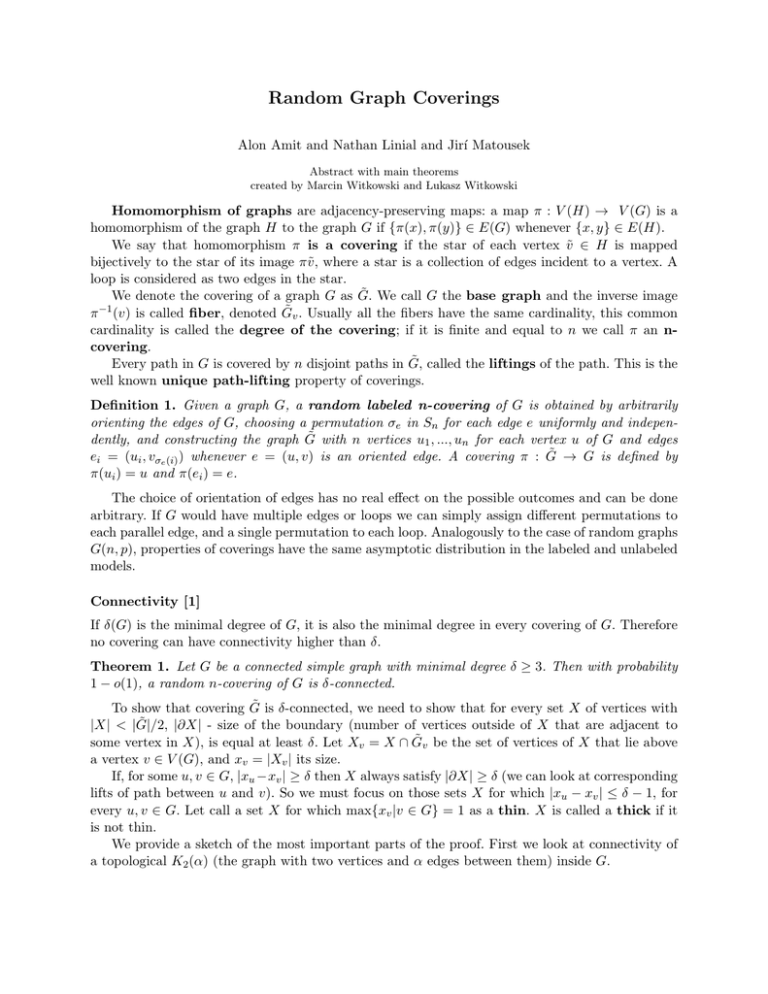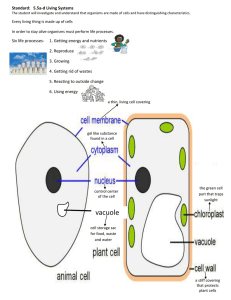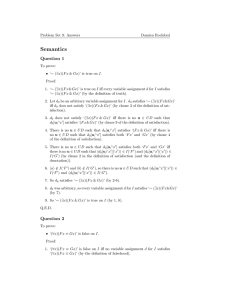Random Graph Coverings
advertisement

Random Graph Coverings
Alon Amit and Nathan Linial and Jirı́ Matousek
Abstract with main theorems
created by Marcin Witkowski and L
̷ ukasz Witkowski
Homomorphism of graphs are adjacency-preserving maps: a map 𝜋 : 𝑉 (𝐻) → 𝑉 (𝐺) is a
homomorphism of the graph 𝐻 to the graph 𝐺 if {𝜋(𝑥), 𝜋(𝑦)} ∈ 𝐸(𝐺) whenever {𝑥, 𝑦} ∈ 𝐸(𝐻).
We say that homomorphism 𝜋 is a covering if the star of each vertex 𝑣˜ ∈ 𝐻 is mapped
bijectively to the star of its image 𝜋˜
𝑣 , where a star is a collection of edges incident to a vertex. A
loop is considered as two edges in the star.
˜ We call 𝐺 the base graph and the inverse image
We denote the covering of a graph 𝐺 as 𝐺.
−1
˜
𝜋 (𝑣) is called fiber, denoted 𝐺𝑣 . Usually all the fibers have the same cardinality, this common
cardinality is called the degree of the covering; if it is finite and equal to 𝑛 we call 𝜋 an ncovering.
˜ called the liftings of the path. This is the
Every path in 𝐺 is covered by 𝑛 disjoint paths in 𝐺,
well known unique path-lifting property of coverings.
Definition 1. Given a graph 𝐺, a random labeled n-covering of 𝐺 is obtained by arbitrarily
orienting the edges of 𝐺, choosing a permutation 𝜎𝑒 in 𝑆𝑛 for each edge 𝑒 uniformly and indepen˜ with 𝑛 vertices 𝑢1 , ..., 𝑢𝑛 for each vertex 𝑢 of 𝐺 and edges
dently, and constructing the graph 𝐺
˜ → 𝐺 is defined by
𝑒𝑖 = (𝑢𝑖 , 𝑣𝜎𝑒 (𝑖) ) whenever 𝑒 = (𝑢, 𝑣) is an oriented edge. A covering 𝜋 : 𝐺
𝜋(𝑢𝑖 ) = 𝑢 and 𝜋(𝑒𝑖 ) = 𝑒.
The choice of orientation of edges has no real effect on the possible outcomes and can be done
arbitrary. If 𝐺 would have multiple edges or loops we can simply assign different permutations to
each parallel edge, and a single permutation to each loop. Analogously to the case of random graphs
𝐺(𝑛, 𝑝), properties of coverings have the same asymptotic distribution in the labeled and unlabeled
models.
Connectivity [1]
If 𝛿(𝐺) is the minimal degree of 𝐺, it is also the minimal degree in every covering of 𝐺. Therefore
no covering can have connectivity higher than 𝛿.
Theorem 1. Let 𝐺 be a connected simple graph with minimal degree 𝛿 ≥ 3. Then with probability
1 − 𝑜(1), a random 𝑛-covering of 𝐺 is 𝛿-connected.
˜ is 𝛿-connected, we need to show that for every set 𝑋 of vertices with
To show that covering 𝐺
˜
∣𝑋∣ < ∣𝐺∣/2, ∣∂𝑋∣ - size of the boundary (number of vertices outside of 𝑋 that are adjacent to
˜ 𝑣 be the set of vertices of 𝑋 that lie above
some vertex in 𝑋), is equal at least 𝛿. Let 𝑋𝑣 = 𝑋 ∩ 𝐺
a vertex 𝑣 ∈ 𝑉 (𝐺), and 𝑥𝑣 = ∣𝑋𝑣 ∣ its size.
If, for some 𝑢, 𝑣 ∈ 𝐺, ∣𝑥𝑢 −𝑥𝑣 ∣ ≥ 𝛿 then 𝑋 always satisfy ∣∂𝑋∣ ≥ 𝛿 (we can look at corresponding
lifts of path between 𝑢 and 𝑣). So we must focus on those sets 𝑋 for which ∣𝑥𝑢 − 𝑥𝑣 ∣ ≤ 𝛿 − 1, for
every 𝑢, 𝑣 ∈ 𝐺. Let call a set 𝑋 for which max{𝑥𝑣 ∣𝑣 ∈ 𝐺} = 1 as a thin. 𝑋 is called a thick if it
is not thin.
We provide a sketch of the most important parts of the proof. First we look at connectivity of
a topological 𝐾2 (𝛼) (the graph with two vertices and 𝛼 edges between them) inside 𝐺.
˜ be a random 𝑛-covering of 𝐺 = 𝐾2 (𝛼), where 𝛼 ≥ 3. Then a.s. every subset
Lemma 1. Let 𝐺
˜
˜
𝑋 ⊂ 𝑉 ((𝐺)) such that 3 ≤ ∣𝑋∣ < 2∣𝐺∣/3
satisfies ∣∂𝑋∣ ≥ 𝛼.
The results can be naturally extend to topological 𝐾2 (𝛼)s (graph with two vertices and 𝛼
disjoint paths between them) as well.
Corollary 1. For a random covering of a topological 𝐾2 (𝛼) with endpoints 𝑎, 𝑏 and 𝛼 ≥ 3 a.s.
˜ with 3 ≤ 𝑥𝑎 + 𝑥𝑏 < 2 ⋅ 2𝑛/3 has ∣∂𝑋∣ ≥ 𝛼.
every set 𝑋 ⊂ 𝑉 (𝐺)
˜ → 𝐺 be a covering such that
Proposition 1. Let 𝐺 be a finite graph with 𝛿 = 𝛿(𝐺) ≥ 3, and let 𝐺
˜
the restriction 𝐻 → 𝐻 satisfies property from Corollary 1 for every 𝐻 that is a topological 𝐾2 (𝛼)
˜ ∣∂𝑋∣ ≥ 𝛿.
with 𝛼 ≥ 3. Then for every thick set 𝑋 ⊂ 𝑉 (𝐺),
Proof of the above theorem uses following Mader’s [4] result.
Theorem 2. In every finite graph 𝐺 there is an edge [a,b] such that
𝜅(𝑎, 𝑏) = min(𝑑𝑒𝑔(𝑎), 𝑑𝑒𝑔(𝑏)).
We can perform similar reasoning for thin sets, proving following statements.
˜ is called edge-thin if it does not contain a pair of
Definition 2. A subgraph 𝐻 of a covering 𝐺
parallel edges, namely edges covering the same edge of the base graph 𝐺.
˜ a random 𝑛-covering. Then a.s. in every edge-thin
Lemma 2. Let 𝐺 be a finite base graph and 𝐺
˜
subgraph of 𝐺, every connected component is a tree or is unicyclic.
˜ → 𝐺 be a covering such that
Proposition 2. Let 𝐺 be a finite graph with 𝛿 = 𝛿(𝐺) ≥ 3, and let 𝐺
˜ satisfies ∣𝐸(𝐻)∣ ≤ ∣𝑉 (𝐻)∣. Then for every thin set 𝑋 ⊂ 𝑉 (𝐺),
˜
every edge-thin subgraph 𝐻 of 𝐺
∣∂𝑋∣ ≥ 𝛿.
Summing up above results we get that both thick and thin sets have 𝛿 neighbours outside them,
˜ is 𝛿-connected.
so 𝐺
Open problems
∙ Let 𝑛 = 𝑛1 ⋅ 𝑛2 ⋅ ⋅ ⋅ 𝑛𝑟 . Starting from 𝐺, we form a random 𝑛1 -covering, then a random 𝑛2 covering of the result and so on. Since a composition of coverings map is itself a covering, the
resulting graph is an 𝑛-degree cover of 𝐺, distributed differently than one formed by taking a
random 𝑛-covering directly. Can we say something about this model?
∙ Estimate the probability that a random 𝑛-covering fails to be 𝛿-connected in terms of 𝑛.
The Independence Number [2]
˜
As usual, let 𝛼(𝐺) denote the maximal size of an independent set in a graph 𝐺. For a set 𝑋 ⊂ 𝑉 (𝐺),
˜ 𝑣 be its intersection with the fiber over 𝑣 ∈ 𝑉 (𝐺). We also set 𝑥𝑣 = ∣𝑋𝑣 ∣.
we let 𝑋𝑣 = 𝑋 ∩ 𝐺
˜ ≥ 𝑛𝛼(𝐺)
Theorem 3. 𝛼(𝐺)
2
Upper bound
˜
Definition 3. A profile on G is a vector 𝜉 = (𝜉𝑣 : 𝑣 ∈ 𝑉 (𝐺)) ∈ [0, 1]𝑉 (𝐺) . A set 𝑋 ⊂ 𝑉 (𝐺)
𝑥𝑣
determines a profile by 𝜉𝑣 = 𝑛 , which represents the way 𝑋 is distributed across the fibers.
Definition 4. For nonnegative real numbers 𝑥1 , 𝑥2 , ...., 𝑥𝑛 with 𝑥1 + 𝑥2 + ... + 𝑥𝑛 ≤ 1, let
∑
∑
∑
𝐻(𝑥1 , ..., 𝑥𝑛 ) = −
𝑥𝑖 log 𝑥𝑖 − (1 −
𝑥𝑖 ) log(1 −
𝑥𝑖 )
𝑖
𝑖
𝑖
be the entropy function (all logs are to the base 2). For real numbers 𝑥, 𝑦 ≥ 0, we set
𝐼(𝑥, 𝑦) = 𝐻(𝑥) + 𝐻(𝑦) − 𝐻(𝑥, 𝑦),
letting 𝐼(𝑥, 𝑦) = ∞ if 𝑥𝑦 > 1. For a profile 𝜉 ∈ [0, 1]𝑉 (𝐺) , let
∑
∑
ℎ(𝜉) =
𝐻(𝜉𝑣 ) −
𝐼(𝜉𝑢 , 𝜉𝑣 )
𝑣∈𝑉 (𝐺)
[𝑢,𝑣]∈𝐸(𝐺)
and
∑
ℎ0 (𝜉) =
𝐻(𝜉𝑣 ) − log(𝑒)
𝑢∈𝑉 (𝐺)
∑
𝜉𝑢 𝜉𝑣
[𝑢,𝑣]∈𝐸(𝐺)
For a subset 𝑆 ⊂ 𝑉 (𝐺), we let
ℎ(𝜉, 𝑆) =
∑
𝐻(𝜉𝑣 ) −
𝑣∈𝑆
∑
𝐼(𝜉𝑢 , 𝜉𝑣 ).
[𝑢,𝑣]∈𝐸(𝐺[𝑆])
Lemma 3. Let 𝐺 be a graph, and let 𝜉 be a profile on 𝐺. The probability 𝑃 that a random 𝑛-lift
˜ of 𝐺 contains an independent set 𝑋 with profile 𝜉 satisfies 𝑃 ≤ 2𝑛ℎ(𝜉) .
𝐺
˜ That is,
Definition 5. We define 𝑎
˜(𝐺) as the best upper bound on 𝛼(𝐺).
}
{
∑
𝑎
˜(𝐺) = max
𝜉𝑣 ∣ℎ(𝜉, 𝑆) ≥ 0 for all 𝑆 ⊂ 𝑉 (𝐺) .
𝜉
𝑣
˜ of G satisfies
Theorem 4. (The first moment upper bound) Almost every 𝑛-lift 𝐺
𝛼(𝐺) ≤ 𝑛˜
𝑎(𝐺) ≤ 𝑛𝑎˜0 (𝐺).
Lower bound
Proposition 3. Let 𝑉 (𝐺) = {𝑣1 , 𝑣2 , ..., 𝑣𝑟 } and suppose that a profile 𝜉 = (𝜉𝑖 : 𝑖 ∈ [𝑟]) satisfies,
for every 𝑘 ∈ [𝑟]
∏
0 ≤ 𝜉𝑘 ≤
(1 − 𝜉𝑖 ).
𝑖<𝑘
[𝑣𝑖 ,𝑣𝑘 ]∈𝐸(𝐺)
∑
˜ of 𝐺 almost surely contains an independent set of
Let 𝑆 =
𝜉𝑖 . For every 𝜖 > 0, a random lift 𝐺
size 𝑛(𝑆 − 𝜖).
Lemma 4. A random 𝑛-lift of a cycle 𝐶 a.s. contains an independent set with 21 𝑛(1±𝑜(1)) vertices
in each fiber.
˜ 𝑟+1 of a complete graph a.s. satisProposition 4. The independence number of a random 𝑛-lift 𝐾
fies
˜ 𝑟+1 ) = 𝛩(𝑛 log 𝑟).
𝛼(𝐾
3
Chromatic Number [2]
Definition 6. Given a graph 𝐺, let
˜ ≤ 𝑘 for a.e. lift 𝐺
˜ of 𝐺}
𝜒
˜ℎ (𝐺) = min{𝑘∣𝜒(𝐺)
˜ ≥ 𝑘 for a.e. lift 𝐺
˜ of 𝐺}
𝜒
˜𝑙 (𝐺) = min{𝑘∣𝜒(𝐺)
Conjecture 1. For every graph 𝐺, 𝜒
˜𝑙 (𝐺) = 𝜒
˜ℎ (𝐺).
Lemma 5. If 𝜒(𝐺) ≥ 3 then 𝜒
˜𝑙 (𝐺) ≥ 3.
Lower bound
Theorem 5. For every graph 𝐺 with 𝜒(𝐺) ≥ 2,
√
𝜒
˜𝑙 (𝐺) ≥
𝜒(𝐺)
3 log 𝜒(𝐺)
Corollary 2. Let 𝐺 be a graph with average degree 𝑑, and suppose that 𝛽 satisfies 𝑑𝛽/2 + ln 𝛽 ≥ 1.
˜ 𝑣 ≥ 𝛽𝑛 for
A random 𝑛-lift ˜(𝐺) o G almost surely contains no independent set 𝑋 such that 𝑋 ∩ 𝐺
every v.
Theorem 6. For every graph 𝐺,
(
𝜒
˜𝑙 (𝐺) ≥ 𝛺
𝜒𝑓 (𝐺)
3 log2 𝜒𝑓 (𝐺)
)
Upper bound
˜ of 𝐺 has the following
Lemma 6. Let 𝐺 be a graph and let 𝑀 be any fixed integer. A random lift 𝐺
˜
property almost surely: Every subgraph 𝐻 ⊂ 𝐺 with ∣𝑉 (𝐻)∣ ≤ 𝑀 also satisfies ∣𝐸(𝐻)∣ ≤ 𝑀 .
Theorem 7. Let 𝐺 be a graph with maximal degree 𝛥 = 𝛥(𝐺). Then
𝜒
˜ℎ (𝐺) ≤
𝛥
(1 + 𝑜𝛥 (1))
ln 𝛥
Proof uses result from [3].
Corollary 3. There exist constants 𝐴 > 𝐵 > 0 such that
𝐴
𝑟
𝑟
≥𝜒
˜ℎ (𝐾𝑟 ) ≥ 𝜒
˜𝑙 (𝐾𝑟 ) ≥ 𝐵
log 𝑟
log 𝑟
Open problems
∙ (Zero-one law) Is there a zero-one law for the chromatic number of random lifts? In particular
is the chromatic number of a random lift of 𝐾5 a.s equal to a single number (3 or 4 ?).
∙ (Gap between chromatic numbers) Are there graphs 𝐺 such that
√the chromatic number of their
random lift is a.s. 𝑜(𝜒(𝐺)/ log 𝜒(𝐺)), or perhaps even close to 𝜒(𝐺).
4
References
[1] Alon Amit and Nathan Linial. Random graph coverings I: General theory and graph connectivity. Combinatorica,
22(1):1–18, 2002.
[2] Alon Amit, Nathan Linial, and Jirı́ Matousek. Random lifts of graphs: Independence and chromatic number.
Random Struct. Algorithms, 20(1):1–22, 2002.
[3] Jeong Han Kim. On brooks’ theorem for sparse graphs. Combinatorics, Probability and Computing, 4:97–132,
1995.
[4] W. Mader. Grad und lokaler zusammenhang in endlichen graphen. Mathematische Annalen, 205:9–11, 1973.
Fig. 1: Figures used in proof of Proposition 1.
Fig. 2: Figures used in proof of Proposition 2.
5





